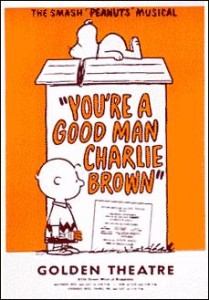Crater Drama’s “You’re a Good Man, Charlie Brown”
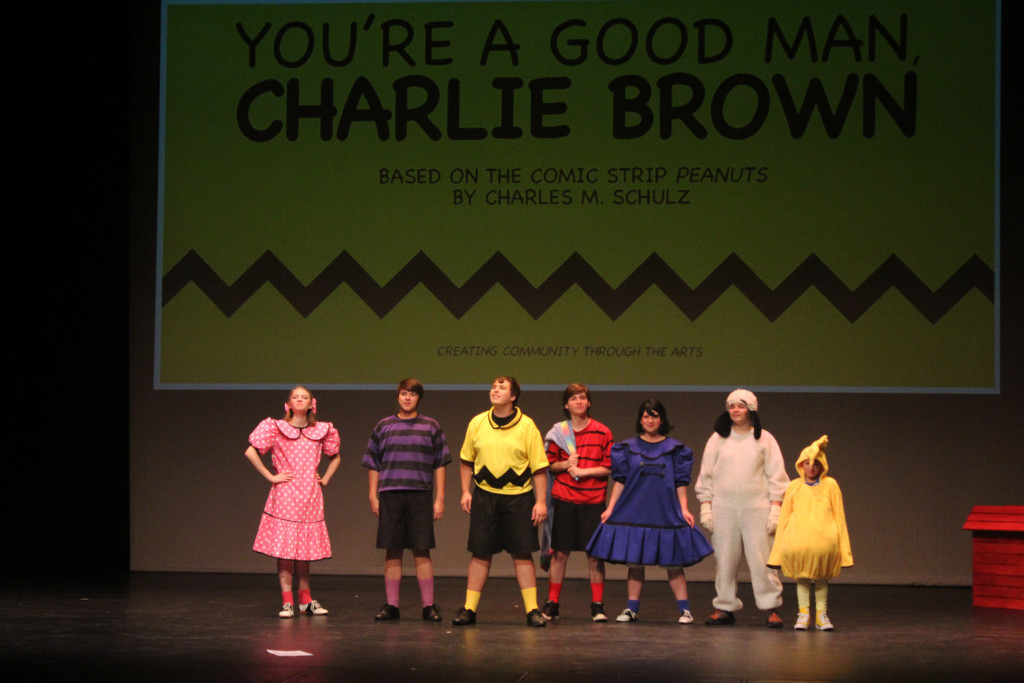
Cast of Crater Drama’s “You’re a Good Man, Charlie Brown” (l-r): Sally (Emma Quackenbush), Schroeder (Dakota Licea), Charlie Brown (Jacob Hearne), Linus (Preston Montgomery), Lucy (Tiffany Aslakson), Snoopy (Cameron Kolpak), Woodstock (Sam Cerekas). Missing: Dancing Blanket (Addison Rivera). Photo by Bailey Hilkey.
Local Drama Students Successfully Bring the Peanuts Gang to Life
– by Lee Greene
Doing what I do, I get to go to a substantial number of theatrical plays and musicals. Most of them are presented by professional or semi-professional theater companies, which charge their audiences a hefty price for the pleasure of enjoying their entertainment. (I have no bone to pick with local theaters, nor complaints about their prices. The harsh reality is that it is expensive to produce a theatrical play well, and the ticket prices generally do not cover the costs, no matter how high the ticket price; if the public wants to be entertained by live theater, the costs do have to be paid for. Besides, I’m usually comped, so it wouldn’t be fair for me to complain about prices.) Normally, a primary aspect of my role in writing about those professional or semi-professional theatrical productions is to assess the quality of the production and performances and advise the prospective audience whether they are getting their money’s worth. It’s a task which the highly acclaimed former theater critic of The New York Times, Clive Barnes has aptly described, saying; “A critic is someone who rides in after the battle and shoots the wounded.” [https://en.wikipedia.org/wiki/Clive_Barnes] But every so often, I have the opportunity to see a student production, where I have the privilege to watch aspiring young actors and production crew at work while honing their craft. The young actors and crew are not really finished products yet, and the standards brought to bear when discussing an educational theater production are different. The task on my part is not about “shooting the wounded”, but observing and appreciating the respective progress of the participating aspiring theatricals in their efforts to learn and polish their craft. I had such an opportunity recently, attending the Crater High School Drama Department’s production of You’re a Good Man Charley Brown.
Before I get to my comments about the Crater Drama production, a little background about the play is in order. (Frequent readers of my reviews know I always do this and it’s just as informative and valuable in the context of this student theatrical, if not more so, than it is in discussing a professional production.) It’s helpful to know that You’re a Good Man Charley Brown happens to be an excellent choice for a student production, and why that’s so. Namely, because the musical You’re a Good Man Charley Brown utilizes a relatively small cast, and more importantly, only very simple staging is required. “The musical has been a popular choice for amateur theatre productions because of its small cast and simple staging.” [Wikipedia, You’re a Good Man Charley Brown, https://en.wikipedia.org/wiki/You’re_a_Good_Man,_Charlie_Brown] Schools, like Crater High, don’t have the same resources available to afford elaborate sets, props, costumes, etc. that the professional theaters do, and cannot charge comparable ticket prices, so the ability to keep things simple, while still presenting entertaining theater, is critical. Credit and kudos are well deserved by Crater Drama Department’s Matthew Reynolds for selecting this entertaining, but very doable musical for the Crater Drama students.
You’re a Good Man Charley Brown is a musical comedy written in 1967 by Clark Gesner, based upon the cartoon characters of the Peanuts comic strip by cartoonist Charles M. Schulz. The original production premiered in New York, off-Broadway in 1967, ran for 1,597 performances and “spawned nine United States touring companies”, a Broadway production in 1971, a 1968 West End London production, another U.S. tour in 1998, and a 1999 Broadway revival. [Id.] The original off-Broadway and ensuing productions feature six characters. With one change along the way, the ultimate cast of characters consisted of Charlie Brown, Lucy, Snoopy, Linus, Schroeder, and Sally Brown (the one change, replacing an early but long missing Schulz character, Patty, not to be confused with Peppermint Patty.) [Id.] The only real requirements for a viable set to present the show are an oversized dog house for the Snoopy character to stand and recline on, an ersatz pitching mound and a kite for Charlie Brown, a small child’s piano for Schroeder, the façade of a 5¢ “Psychiatryk Help” booth for Lucy, and a blanket for Linus.
The play is divided into two acts. The song list has varied from production to production but as of the 1999 Broadway revival consisted of 15 songs divided between two acts.
Act 1
Charlie Brown stands alone as his friends give their various opinions of him, each overlapping the other. Today everyone is calling him a “good man”. Charlie Brown is happy and hopeful as usual, but he nevertheless wonders if he really is what they say. He decides to find out how he can really become a good person (1. “Opening/You’re A Good Man, Charlie Brown”).
Alone one day, during lunch, Charlie Brown talks about his bad days. Then he notices the Little Red-Haired Girl and decides to go sit with her. However, he cannot find the courage to do so.
Lucy expresses her deep infatuation with Schroeder and asks him what he thinks of the idea of marriage. Schroeder is aware of her feelings, but remains aloof as he plays his piano. Lucy then exclaims: “My Aunt Marion was right. Never try to discuss marriage with a musician” (2. “Schroeder”). Sally is sad because her jump rope tangled up.
Snoopy is lying on top of his doghouse, relaxing vacantly and peacefully. He begins to daydream about being a wild jungle beast. In a few minutes, however, he is back to his peaceful state (3. “Snoopy”). Linus enters, holding his blanket and sucking his thumb. Lucy and Sally show up and mock him for this habit. Linus decides to abandon his blanket and move on, only to come running back to it in desperation. After the girls leave, Linus daydreams of a blanket fantasy where everyone can relax with their blankets (4. “My Blanket and Me”). Lucy later tells him that she would someday like to be a queen. However, Linus tells her that she can’t and she threatens to punch him. Sally gets a C for her pathetic coat-hanger sculpture.
Charlie Brown appears, trying to get his unusually stubborn kite to soar in the air. Eventually, he succeeds in doing this, and he enjoys a few minutes of triumph before the notorious Kite-Eating Tree eats it up (5. “The Kite”). After this trauma, Charlie Brown tries to find the right way to give The Little Red-Headed Girl her Valentine’s Day card, but he ends up saying “Merry Christmas”, making a fool out of himself. He goes to see Lucy, who is at her psychiatrist booth. He tells her all the things he thinks of himself. Lucy then clears it up by saying that Charlie Brown is unique the way he is, then asks for the five cent price (6. “The Doctor Is In”). Later, Charlie Brown sees a happy Schroeder spreading the word of Beethoven’s birthday and pulling together a celebration. He and company join Schroeder in the song of jubilation (7. “Beethoven Day”).
At noon, Linus, Lucy, Schroeder, and Charlie Brown are working on their Peter Rabbit book reports, each in his or her own way. Lucy is simply babbling to fit the 100-word requirement, Schroeder is doing a “comparison” between the book and Robin Hood, Linus is doing an overcomplicated psychological analysis, and Charlie Brown hasn’t even started out of worry, while Sally and Snoopy chase rabbits (8. “The Book Report”).
Act 2
Snoopy, in his World War I flying ace uniform climbs atop his doghouse. He goes through a scene, with him being a pilot searching for the Red Baron. In his imagination, he is defeated by the Red Baron and returns to the airdrome in France.
Sally is clearly cross about a D her teacher gave her on her homework assignment. In response, she says, “Oh, yeah? That’s what you think!” Schroeder hears and asks why Sally is telling him that. It quickly becomes Sally’s new “philosophy”, and she bursts into song about her philosophies. Schroeder, after failing to explain to her how philosophies work, leaves in bafflement while Sally continues (9. “My New Philosophy”).
Charlie Brown returns, and, with his friends, plays the Little League Baseball Championship. After some mishaps, the team finally manages to make some progress. Charlie Brown steps up to the plate, and despite his valiant efforts, strikes out and loses the game. We learn that this was a flashback, and Charlie Brown expresses his deep sorrow to his pen pal (10. “T-E-A-M (The Baseball Game)”). Lucy takes a crabbiness survey and Linus says that her crabbiness rating is ninety-five. After punching him, she realizes that she, in reality, is really very crabby.
Determined not to let what happened at the championship bother him, Charlie Brown decides to join Schroeder’s Glee Club and cheer up by singing “Home on the Range” with his friends. Unfortunately, a fight ensues between Lucy and Linus over a pencil. The fight spreads, and Charlie Brown decides to leave with his angry friends, leaving Schroeder and Snoopy the only ones singing (11. “Glee Club Rehearsal”).
Later, Charlie Brown comes across Lucy teaching Linus about nature the way she views it with such as bugs making the grass grow or eating eagles for Thanksgiving and Christmas. Charlie Brown tries to correct her, but she retaliates with a false explanation, and Charlie Brown bangs his head against a tree in frustration (12. “Little Known Facts”). That evening, Snoopy complains that he hasn’t been fed yet, and begins to overcomplicate and dramaticize the matter until Charlie Brown shows up with his dinner. Snoopy bursts into song about his craving for supper until Charlie Brown firmly tells him to eat his meal (13. “Suppertime”).
That night, Charlie Brown is sad that he still has not discovered what it means to be a “good man”. He proudly displays a pencil which had been dropped by the Little Red-Haired Girl (his perennial crush). As he examines it, he discovers that “there are teeth-marks all over it . . . she nibbles her pencil . . . she’s HUMAN!” With that realization, he concludes that today hasn’t been so bad, after all, and he’s done a lot of things that make him happy. As Charlie Brown expresses what makes him happy, everyone, touched by his love of life, begin to express what makes them happy as well (14. “Happiness”). Right then, he realizes being a “good man” means trying your best and making the most of the things you’ve been given in life. As his friends leave the stage, Lucy walks over and puts out her hand, making him shrink back. As he reaches out, she shakes his hand firmly, then tells him, “You’re a good man, Charlie Brown.” (15. Bows/partial reprise of “Happiness” and “You’re A Good Man, Charlie Brown”)
[Synopsis from Wikipedia, You’re a Good Man Charley Brown, https://en.wikipedia.org/wiki/You’re_a_Good_Man,_Charlie_Brown]
Author Clark Gesner explains, “None of the cast is actually six years old. And they don’t really look like Charles Schulz’ “Peanuts” cartoon characters. But this doesn’t seem to make that much difference once we are into the play, because what they are saying to each other is with the openness of that early childhood time, and the obvious fact is that they are all really quite fond of each other.” [Id.]
Which is a good point to begin the discussion of the Crater Drama production, because the cast of the Crater show all collectively succeeded in bringing the Peanut characters to life. Despite any shortcomings in any of their respective performances, by the show’s final curtain, every one of them had succeeded in producing a portrayal which achieved the theatrical holy grail of suspension of disbelief: even though they might not have looked or behaved exactly like the respective cartoon character they were portraying, the audience had come to accept each of them as a quite real embodiment of their respective characters, along with the interactions and relationships between them, just as described by Charles Schulz in the cartoon strip.
The Crater Drama production largely followed the script of the Broadway revival above, with a few minor modifications, plus the addition of two more cast members: one an additional Peanuts character, the bird, Woodstock, and the second a dancer, in the role of a dancing blanket, enabling Linus to literally dance with his blanket during his blanket fantasy.
The production overall, while simple, was well done. All of the requisite set and prop pieces were present and well executed. The different and changing scenes were framed by mammoth back-of-the-stage projections, very much like frames of the comic strip, and all very appropriate to the scene they were projected for. Music was provided by an accompaniment sound track played over the theater sound system. The singing was universally in sync with the accompaniment, in tune, and well done. The costumes were great and very much helped to define the characters. Lighting was also well handled, with appropriate spotlighting right where it ought to be in the different scenes. The student crew handling all of these things deserves high marks for doing it all well, all in time, on time, never too late, too loud, too soft, too bright, too dark or too bad. So kudos to Sound Technicians Justice Lawrence and Emme Herring, Lighting Designer Jared Lawrence, Costumer Sue Quackenbush, Stage Manager Aundrea Gillespie, Prop Mistress Danielle Bonilla and Set Carpenter Steve Sargent. And of course high praise for Musical Director Amanda Klein and Director/Choreographer Matthew Reynolds for pulling it all together.
As noted above, each of the cast member’s performances was successful in presenting the respective depicted characters. Each of the actors had particular strengths (and perhaps weaknesses), and each provided memorable bits. As regular readers of my reviews know, I take copious notes during a performance, and I’d like to share here some of the highlights from them of the student thespian portrayals. First up, it is an unexpected and pleasant surprise to discover a gifted, polished, natural actor or actress in a student theatrical production, and there was indeed one such actress on the stage in this show.
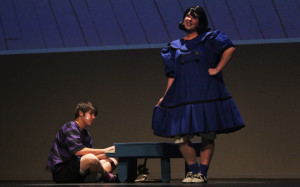
Lucy (Tiffany Aslakson) at Schroeder’s (Dakota Licea) piano in Crater Drama’s “You’e a Good Man Charlie Brown”. Photo by Bailey Hilkey.
My notes are just filled with accolades, plaudits, and praise for actress Tiffany Aslakson, who played Lucy. Ms Aslakson didn’t just portray Lucy, she fully and completed inhabited and embraced the character. She is a natural actress – she didn’t merely recite lines, she projected them clearly, audibly, and to the audience. But her lines were just a small part of a total performance, with wonderful and effective movement, gestures, facial expressions and behavior. Her Lucy was absolutely hysterically funny, and in just the ways Charles Schulz presents the character in the cartoon strip. And if it sounds like she was stealing the other actors’ thunder – that would be a misimpression, because just the opposite was true. She was giving the other actors a performance to feed off of, helping everyone else on stage to find their roles in their interactions with her character. Ms. Aslakson patently has a promising future ahead as an actress, and when asked about it, the graduating senior indeed professed a desire to go on in theater and drama. Her first choice, after graduating from Crater High in spring 2016, would be to study drama in the Theater Department of Ashland’s Southern Oregon University. If anyone from the S.O.U. Theater Department is reading these reviews, take note of that fact and do something about it. With the benefit of some good drama training from the S.O.U. Theater Department, Ms. Aslakson may well turn out to be the next Ty Burrell story for the department, with her photo on the wall in the new theater building and a successful show business career after graduation. Better take her up on her desire to study there, before she gets lured to Pace University, Carnegie Mellon, CalArts or American Conservatory Theater.
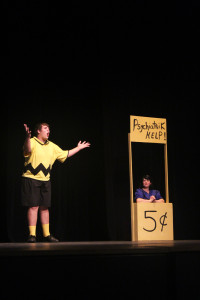
Charlie Brown (Jacob Hearne) getting advice from Lucy (Tiffany Aslakson) in Crater Drama’s “You’re a Good Man, Charlie Brown”. Photo by Bailey Hilkey.
Jacob Hearne gave a winning performance as Charlie Brown. His Charlie Brown was very funny, and highly entertaining, much as the cartoon character is. He is given more monologues in the show than any of the other characters and he acquitted them well. If there is such a thing as proper timing and cadence for delivering the lines of a cartoon character, Mr. Hearne indeed mastered the art of voicing Charlie Brown. Whether swinging an invisible bat, flying a virtual kite, or obsessing over an always off-stage “Little Red-Haired Girl”, Mr. Hearne had us believing what was unseen.
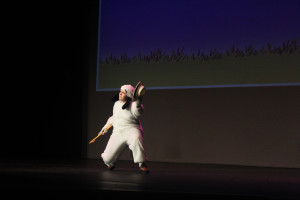
Snoopy (Cameron Kolpak) dancing “Suppertime” in Crater Drama’s You’re a Good Man Charlie Brown”. Photo by Bailey Hilkey.
Cameron Kolpak gave us a compellingly lovable Snoopy. His bits were some of the most memorable in the show. There’s quite nothing else that can compete with his performance of Snoopy doing a Fred Astaire dance routine, with hat and cane. He won our sympathy with his Red Baron fantasy, atop the dog house in aviator cap and goggles, and more than his share of giggles and laughs as he howled along during Glee Club Rehearsal.
As Linus, Preston Montgomery was endearing, sucking his thumb quite believably in all the right times and places. He completely sold us on his attachment to that blanket. And then there was that wonderful fantasy dance sequence with the dancing blanket – not just amusing, but well danced.
Dakota Licea as Schroeder was an image right out of the Peanuts comic strip. He looked like the comic Schroeder, he behaved like Schroder in the cartoons, and when he sat playing the tiny piano, with Lucy leaning over it, it was an image right out of the Peanuts strip come to life.
In the role of Sally, Emma Quackenbush, may have been the best singer in the cast, singing “My New Philosophy”. She was also very amusing in chasing rabbits with Snoopy, and again when announcing that she was mad. Sam Cerekas as Woodstock had the wordless mime role in this cast. He never gets to actually say anything, but was terrifically communicative with gestures, faces and movements. Finally, Addison Rivera, as the dancing blanket deserves kudos for being the best dancer in the ensemble.
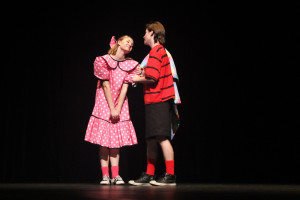
Sally (EmmaQuackenbush) and Linus (Preston Montgomery) in Crater Drama’s “You’re a Good Man Charlie Brown”. Photo by Bailey Hilke.
The entire cast deserves an A+ for courage, to take on these roles and get out onto that big, largely empty, stage and perform these characters, in front of a large auditorium filled with audience members. It takes quite a bit of fortitude and confidence to do that. But none of them hesitated; there was not one wince, or visible moment of doubt. I have to assume that teacher and director Matthew Reynolds not only had them all well prepared to take the stage and present these performances, but that he also did a great job beforehand of picking his actors for each of the roles. Did I mention that Mr. Reynolds himself is an MFA graduate of the S.O.U. Theater Department? The bottom line: the most important take-away from this production is that drama is alive and well at Crater High School.
All photos (except theater poster) by photographer Bailey Hilkey.
